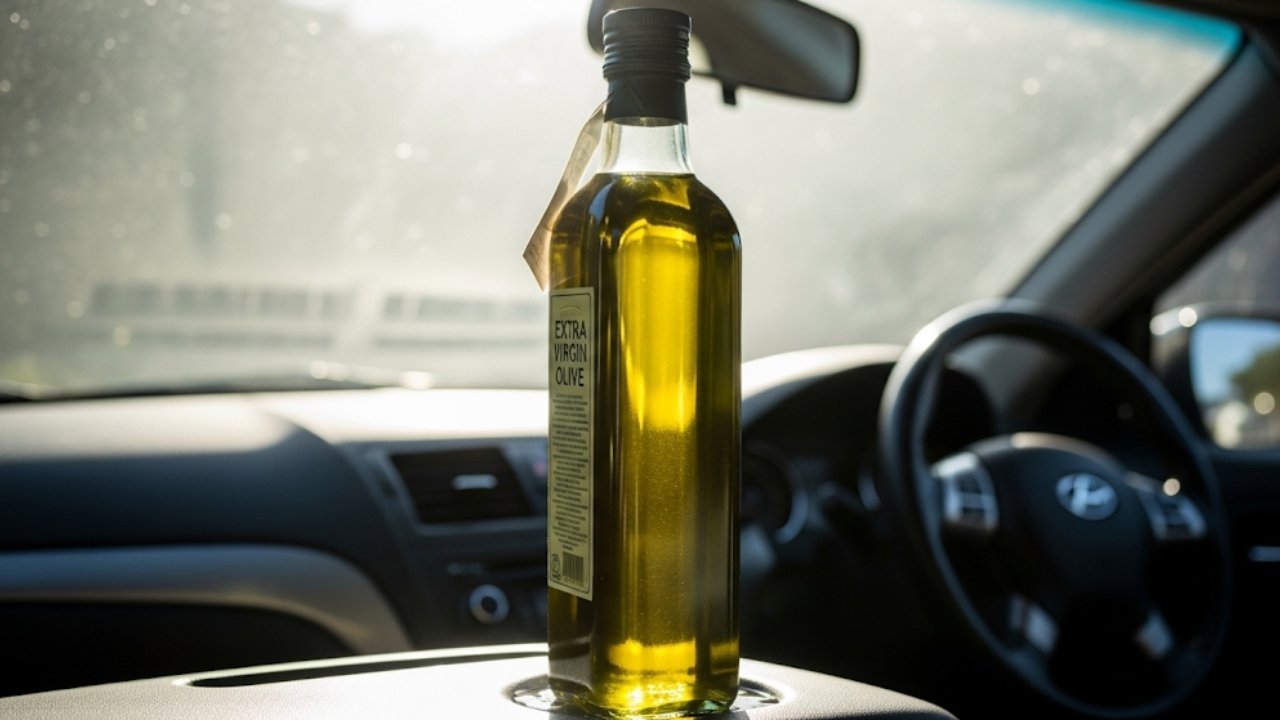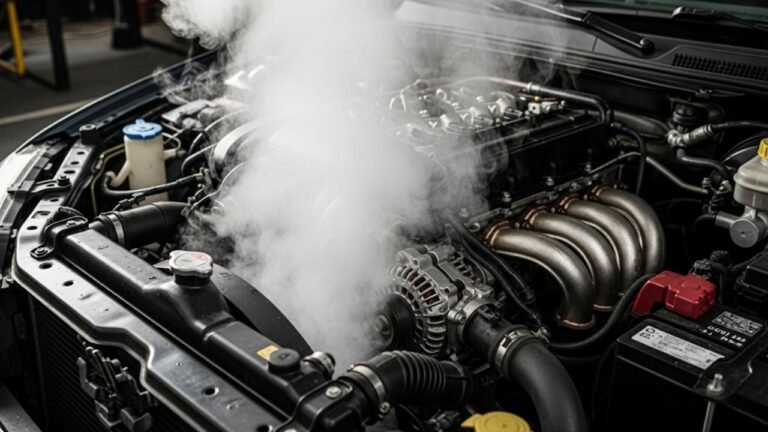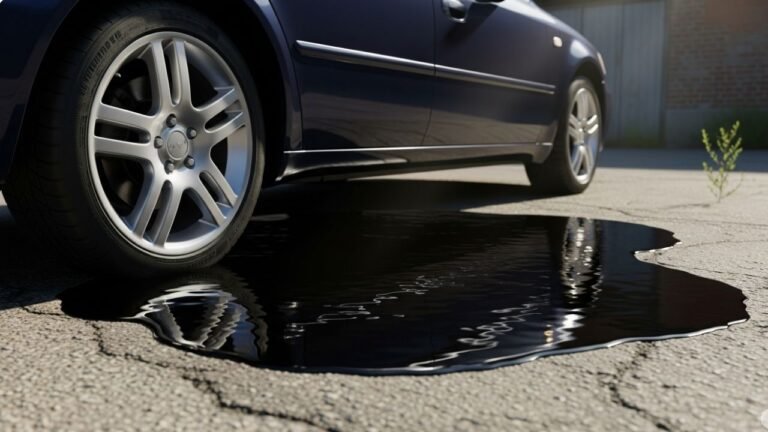Can Olive Oil Sit in a Hot Car?

We’ve all had one of those moments—you’re rushing home from the grocery store on a hot summer day, the sun is blazing, your windows are rolled up, and then you remember… that bottle of olive oil is sitting in your car trunk. You ask yourself, “Can olive oil sit in a hot car without going bad?” It’s a simple question, but the answer is surprisingly layered.
Living in a warm country like Bangladesh, India, or the southern U.S., this issue feels even more real. I’ve personally forgotten my groceries in the car more than once. And each time, I’m left wondering whether that golden liquid in the bottle is still okay to use or if I just turned it into some weird, health-risk version of itself.
In this article, we’ll explore how heat affects olive oil, whether it’s safe to consume after sitting in a hot car, and what signs to look for if it’s gone bad. We’ll also dig into storage tips, best practices, scientific reasoning, and real-life experiences—so you’ll never second-guess your olive oil again.
Let’s crack open this bottle of knowledge!
How Heat Affects Olive Oil at a Molecular Level

When olive oil sits in a hot car, especially in summer when temperatures can soar above 100°F (38°C) inside a vehicle, it starts to degrade. High heat accelerates oxidation, which is a chemical reaction that breaks down the oil’s nutrients and freshness. Oxidation leads to rancidity, which basically means the oil goes stale and starts to smell or taste off.
Here’s a quick breakdown of what happens to olive oil under heat:
| Temperature (°F) | Effect on Olive Oil |
|---|---|
| Below 70°F | Ideal for storage, preserves quality |
| 70–85°F | Safe, but long-term storage not ideal |
| 90–100°F | Begins to degrade gradually |
| 100°F+ | Increases oxidation; risks turning rancid |
| 120°F+ | Rapid nutrient loss and flavor damage |
In short, leaving olive oil in a hot car is a fast track to lowering its quality, even if it doesn’t go visibly “bad” right away.
Can Olive Oil Sit in a Hot Car for a Few Hours?
Now here’s the good news: if it’s just a few hours, your olive oil probably won’t turn into a disaster.
From personal experience—and countless chats with friends and neighbors—most people who’ve left olive oil in their hot cars for a short time didn’t notice an immediate issue. However, the risk increases with repetition. If it happens often, your oil might lose its freshness faster than expected.
Think of it like leaving chocolate in a hot car. Once might not ruin it, but do it again and again, and you’ll be left with a weird-tasting mess. The same applies here.
Here’s a simple rule:
-
Less than 3 hours in a hot car: Usually safe.
-
More than 3 hours, especially in 100°F+ conditions: Check for changes in smell, taste, or color.
-
Multiple times over days or weeks: The oil will likely degrade significantly.
So, can olive oil sit in a hot car for a little while? Technically yes, but it’s not a habit you want to form.
Signs That Your Olive Oil Has Gone Bad from Heat
You don’t need a chemistry degree to figure out if your olive oil has been damaged. You just need your nose, tongue, and eyes.
Let me tell you a little story.
One summer, I left a bottle of extra virgin olive oil in my car while running errands. It was a blazing 104°F outside. When I finally got home and opened the bottle, something felt…off. It didn’t smell like that fresh, grassy aroma I was used to. It smelled like crayons.
Yes, crayons.
That’s the classic sign of oxidized oil. Here are more signs your olive oil may have turned bad due to heat exposure:
-
Smell: Rancid olive oil smells like crayons, glue, or putty.
-
Taste: Instead of being fruity or peppery, it will taste flat, greasy, or stale.
-
Color: While color isn’t the most reliable sign, an olive oil that’s gone cloudy or darker than usual might be compromised.
-
Consistency: If it feels extra sticky or thick at room temperature, it might be a sign of chemical breakdown.
The moment you notice these signs, toss the oil. Using bad olive oil doesn’t just ruin your food—it might also introduce free radicals into your body, which are linked to cell damage and inflammation.
Why Proper Storage Is Everything for Olive Oil
Olive oil is like that high-maintenance friend we all love—amazing when treated right but sensitive to every little thing. To keep it fresh, how you store it is just as important as what type you buy.
Heat, light, and air are the three enemies of olive oil.
Here’s how to store it properly:
-
Keep it cool: Between 57°F and 70°F is ideal.
-
Avoid direct sunlight: Always keep the bottle in a dark cupboard or pantry.
-
Use dark bottles: They help block light and slow down oxidation.
-
Seal it tight: Close the cap properly to avoid air exposure.
So if you’re thinking, “Can olive oil sit in a hot car if I just bought it from the store?”—maybe once. But if you’re storing olive oil in your car for any reason—just don’t. It’s like storing milk on the dashboard.
Real Stories: What People Say About Leaving Olive Oil in Cars
Let’s go beyond science for a minute. What do real people say?
I asked a few friends and looked around online. Here are some real experiences:
“I left a bottle in my trunk for an entire day. It looked okay but tasted flat.”
– Nina from Florida
“It turned cloudy and thick, almost like it was congealing. Never buying olive oil in the summer again unless I go straight home!”
– Arif from Dhaka
“Honestly, I didn’t notice anything different. But I used it up within a week.”
– Jamie from California
These stories show that results vary. Sometimes you might get away with it. Other times, not so much. But is it worth the gamble?
Quick Tips to Prevent Olive Oil from Overheating in a Car
If you absolutely have to leave your olive oil in the car, here are some survival hacks:
-
Wrap it in a towel: Helps insulate it from heat.
-
Put it in a cooler bag: Even a simple thermal bag can make a difference.
-
Store it under the seat: The floor of the car stays cooler than the trunk.
-
Avoid keeping it for long: Make the car-to-kitchen trip quick.
-
Use a travel cooler: Great if you’re shopping during peak summer hours.
Bullet Summary: Key Do’s and Don’ts
✅ Do:
-
Store in cool, dark places.
-
Use thermal bags if transporting in hot weather.
-
Check smell and taste before use.
❌ Don’t:
-
Leave in a hot car for long.
-
Expose it to direct sunlight.
-
Store in a clear bottle long-term.
Long-Term Heat Exposure: What Happens to Olive Oil Over Time?
While a few hours in the heat may not seem catastrophic, long-term or repeated exposure to high temperatures can be a silent killer for olive oil. Even if it looks fine on the surface, every time the oil heats up past its comfort zone, its flavor molecules, nutrients, and health benefits start to fade.
Heat speeds up oxidation, which not only dulls the flavor but creates free radicals. These unstable molecules can cause damage when consumed regularly, especially if you’re using olive oil for cooking or drizzling over salads for health reasons.
Over time, heat also breaks down the delicate polyphenols, which are responsible for olive oil’s anti-inflammatory and antioxidant effects. What’s left is an oil that may still work for frying, but won’t give you the health kick or delicious taste you were expecting.
So, if you’ve got a habit of leaving olive oil in your car’s trunk after groceries or during travel, try to break that pattern. It’s like putting your most expensive perfume in the sun—it loses its magic even if the bottle looks full.
Cultural Insights: How We Treat Oil in Warm Regions
Coming from a hot climate myself, I can tell you that managing food during the summer is practically an art form. Growing up in Bangladesh, we often avoided shopping for perishables or sensitive items in the middle of the day. Instead, my mother insisted on early morning market trips. And if she had to buy olive oil, it went straight from the store to our kitchen shelf—no side trips, no delays.
In Mediterranean countries where olive oil is practically liquid gold, people are even more particular. You’ll often find it in ceramic jars, kept far from ovens, windows, or any heat source. Italians, Greeks, and Spaniards treat it with reverence—and for good reason. Once you’ve tasted real, fresh olive oil, you’ll never want to go back to a bottle that’s been heat-damaged.
It’s almost like a cultural code: If you care about flavor, treat your oil right.
Science Backs It Up: What the Research Says
A 2014 study published in the Journal of Food Chemistry found that heat exposure significantly reduced the antioxidant content in extra virgin olive oil. After only 24 hours at 98°F (37°C), the oil’s quality markers started to drop. Another study by the University of California, Davis Olive Center concluded that high temperatures sped up rancidity even before the oil’s expiration date.
These studies confirm what many of us observe firsthand. It’s not just your imagination—the heat really does change the oil’s structure and effectiveness. This science makes it even more crucial to avoid letting olive oil sit in a hot car, especially repeatedly.
What’s the Best Type of Bottle for Transporting Olive Oil?
If you’re someone who frequently transports olive oil—maybe you’re a chef, a vendor, or just doing a big grocery run—it’s wise to choose the right kind of bottle. The packaging makes a big difference when it comes to resisting heat damage.
Here’s a breakdown of common containers:
| Container Type | Heat Resistance | Pros | Cons |
|---|---|---|---|
| Dark glass bottle | ★★★★☆ | Blocks light, slows oxidation | Fragile, not ideal for travel |
| Stainless steel tin | ★★★★★ | Best insulation, travel-safe | Heavier, more expensive |
| Plastic bottle (clear) | ★☆☆☆☆ | Lightweight, cheap | Easily damaged by heat/light |
| Ceramic jug | ★★★★☆ | Good protection, stylish | Breakable, not common in stores |
If you must take olive oil on the go in hot weather, go for stainless steel or a dark glass bottle inside a cooler bag. It may seem like overkill, but you’ll thank yourself when your meals still taste fresh and the oil keeps its nutrients.
Quick Table Recap: Can Olive Oil Sit in a Hot Car?
Let’s summarize everything we’ve learned so far in a handy table:
| Scenario | Risk Level | Advice |
|---|---|---|
| 1 hour in a hot car | Low | Still safe, but don’t repeat often |
| 3+ hours on a 100°F day | Medium | Check smell, taste, and color |
| Stored in car repeatedly over summer | High | Likely oxidized, nutrient loss |
| Transported in stainless steel container | Very Low | Ideal for travel in warm climates |
| Left in plastic bottle in direct sun | Very High | Likely rancid, discard if altered |
Real-Life Tip: How I Fixed the Heat Mistake
So, a few years back, I brought home a fancy bottle of cold-pressed olive oil from Turkey. Without thinking, I left it in my backseat while stopping by a friend’s place. Two hours later, the car felt like an oven. I was devastated. The oil didn’t smell horrible, but it lost that zingy, herbal punch I remembered when I first tasted it.
I ended up using it for basic cooking instead of salads or dipping bread. Since then, I never travel with olive oil without a cooler bag.
Lesson? Even if it looks okay, heat steals the soul of olive oil. Protect it like you would your phone or laptop in summer.
FAQs About Olive Oil and Heat
We’ll dive into more detailed FAQs in the second half, but here are a few common questions to get us started:
Q1: Does olive oil spoil in heat?
Yes, prolonged exposure to high heat accelerates oxidation and nutrient loss.
Q2: Can I still use olive oil that sat in my car?
If it was for a short time (under 3 hours), probably. But check smell and taste.
Q3: Does the bottle type matter in heat?
Yes! Dark glass bottles help protect the oil from light and heat damage.
Q4: Can I refrigerate olive oil after it’s been heated?
You can, but it won’t reverse the damage. Prevention is better than cure.
Q5: Is cloudy olive oil from heat harmful?
Cloudiness alone isn’t harmful, but check for smell and taste to be sure.
Q6: Can I still cook with olive oil that’s been in a hot car?
Yes, if it hasn’t gone rancid. For frying or sautéing, slightly oxidized oil may still work. But don’t use it raw or for finishing dishes.
Q7: Does refrigeration help fix heat-damaged olive oil?
No. Refrigerating might slow further degradation but won’t reverse oxidation. It’s better to prevent heat exposure in the first place.
Q8: Can I freeze olive oil for long trips?
Technically yes. Olive oil solidifies around 40°F (4°C). Just make sure the container can handle expansion and thaw it gently.
Q9: Why does my olive oil smell like playdough or paint?
That’s a classic sign of rancidity from heat or age. It’s no longer good and should be discarded.
Q10: Can I mix old olive oil with fresh to balance it?
You can, but you risk reducing the quality of the good oil. It’s not recommended unless you’re using it for non-food purposes.
Final Thoughts: Respect the Oil, Respect the Flavor
So, can olive oil sit in a hot car? Technically, yes—for a little while. But the more it happens, the more you risk ruining its delicate flavor, nutrients, and health benefits.
Olive oil is alive. It breathes, reacts, and evolves. It’s more than just cooking fat—it’s part of cultural traditions, health practices, and culinary art. That’s why it deserves care, even during transport.
Next time you do your grocery run or travel with olive oil, just remember: your car may be fine in the heat, but your olive oil isn’t. Treat it like a treasure and it will reward you every time you pop that cap and pour it onto your food.






